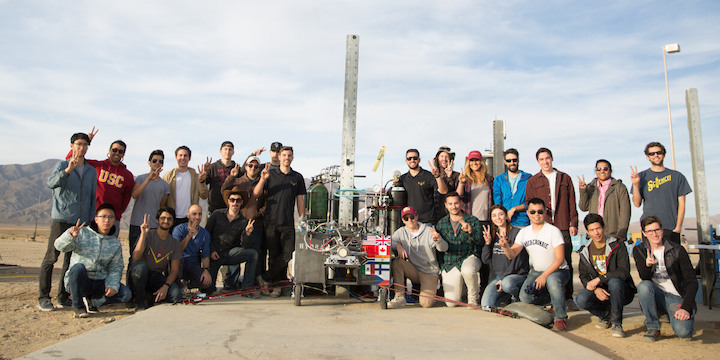THE LIQUID PROPULSION LAB WITH THEIR ENGINE AND TEST STAND PRIOR TO THE SUCCESSFUL TEST FIRE IN DECEMBER 2017. PHOTO/LPL
In collaboration with the Kyushu Institute of Technology in Japan, the USC Liquid Propulsion Lab in the Department of Astronautical Engineering is pushing the limits of what a student laboratory can do in propulsion technology.
Following a successful test fire of their engine and new test stand in December, they entered the new year with big plans. After building and testing USC’s first 3-D printed rocket engine this spring, next winter they will launch a completed rocket built with Kyushu Institute of Technology (Kyutech) using two of their unique 3-D printed engines.
The one-ton rocket will reach an altitude of approximately 20,000 feet, just half the height at which commercial planes fly. It will mark their first step to reaching higher altitudes and eventually space.
“It will be one of the most powerful student-built engines in the world and we will be the first student team ever that will use two engines on one flight vehicle,” said Jan Fessl, Liquid Propulsion Lab (LPL) co-lead engineer and master’s student in USC Viterbi’s Department of Astronautical Engineering (ASTE).
In their collaboration, LPL is in charge of the propulsion system, including the rocket engine, the fuel feed systems and the associated electronics. Meanwhile, students from Kyutech’s Space Systems Laboratory are building the flight vehicle, which includes the aerodynamic shell, the parachute recovery system and the majority of the electronics system. Materials like fuel tanks and reaction control systems, used to stabilize and position the rocket, are being supplied by the Japanese space agency (JAXA) and several Japanese companies. LPL receives funding from USC and external sponsors interested in supporting liquid rocketry.
To integrate their components, USC student LPL member Peter Bennion is spending the semester in Japan at Kyutech. Bennion, an ASTE master’s student, is able to continue his graduate coursework while abroad through the online DEN@Viterbi program.
“I’m designing and implementing the interface between our rocket and their flight electronics,” Bennion said. “LPL will have its own self-contained control system, but once it gets strapped to Kyutech’s airframe, we will need a way to talk to it from the ground.”

LPL MEMBERS WITH KYUTECH STUDENTS DURING A 2016 VISIT AT USC. PHOTO/LPL
Kyutech’s vehicle is equipped with an onboard network that lets the different components talk to each other, such as the antenna, data recorder and flight computer, and Bennion is working to incorporate the computer that controls their engine into that network.
“I’m also contributing to the design of our flight hardware. For instance, making sure everything gets power, figuring out where our cables will go, helping to determine flight procedures and emergency safety equipment and so on,” Bennion said.
Formed just three years ago as an off-shoot of the USC Rocket Propulsion Lab(RPL), LPL has since grown to include 35 members and is structured to allow all students to participate. The program gives students an opportunity to explore liquid propulsion technologies commonly used by companies like SpaceX and Virgin Galactic, which are different than the solid propellants used by RPL.
“Liquid propulsion systems are far more complex and their development requires knowledge of fluid dynamics and thermodynamics,” Fessl said. “Nowadays, the industry uses mainly liquid propulsion systems for their reliability, reusability and efficiency.”
While their work focuses on advanced rocketry research, the team is modeled to reflect an industry environment, providing a real-world experience to the cohort of primarily graduate students. “We’re providing an operational engine to a customer,” explained Bennion. “We don’t have complete control over the entire system, so our product needs to meet the requirements Kyutech specifies.”
They are advised by David Barnhart, research professor in astronautics and director of the Space Engineering Research Center.
“It’s outstanding to see engineering theory reduced to practice before students graduate at USC,” Barnhart said. “They are working on systems that are truly enabling second generation applications in space today.”

